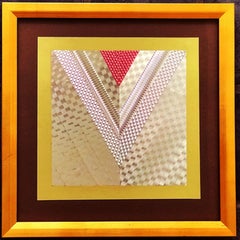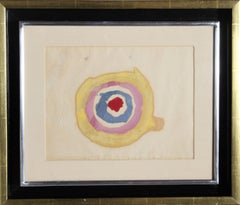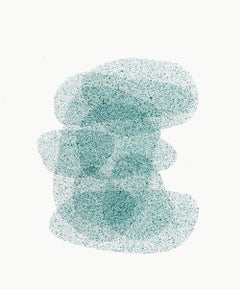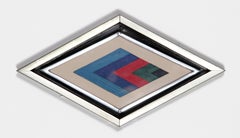Kenneth Noland Drawings and Watercolor Paintings
American, 1924-2010
Kenneth Noland was an American painter. He was known as one of the best American color field painters, although in the 1950's he was thought of as an abstract expressionist and in the 1960's as a minimalist painter. He is most famously known for his target paintings. Noland also helped establish the Washington Color School movement.(Biography provided by Hartmann Gallery)
to
2
4
3
2
1
1
3
1
Overall Height
to
Overall Width
to
3
4
2
2
22
706
412
288
228
3
2
2
1
1
Artist: Kenneth Noland
Monotype with hand painting geometric abstraction by renowned color field artist
By Kenneth Noland
Located in New York, NY
Kenneth Noland
Untitled, 1987
Monotype with hand painting on wove paper
Hand signed and dated with artist's copyright in pencil on the back; also with the blind stamp/chop mark lower...
Category
1980s Color-Field Kenneth Noland Drawings and Watercolor Paintings
Materials
Acrylic, Monotype, Pencil, Screen
Untitled Chevron Collage, de-accessioned from the Honolulu Museum of Art
By Kenneth Noland
Located in New York, NY
KENNETH NOLAND
Untitled, for Trustees of the Honolulu Museum of Art, 1984
Mixed Media collage with silver and colored foil on board.
Signed on verso (back) with personal inscription. "for Twig and Laila" (Trustees of the Honolulu Museum of Art), Deaccessioned from the Honolulu Museum of Art Collection
Inscription done in black marker and reads: "A Little Exercise For Twig and Laila With Thanks For A Wonderful 3 Days At ' Cedar House' On The 'Big Island'... 1 Sept 1984 Honolulu Hawaii."
Frame included
Measurements
Framed:
12.5" x 12.5" x .3"
Artwork:
8.75" x 8.75"
This reflective Chevron collage was de-accessioned by the Honolulu Museum of Art. In 2018, it was exhibited in the show "On Black Mountain: The Bauhaus Legacy in America", April 5, 2019-April 27, 2019 at the Sager Braudis Gallery in Columbia, Missouri, and is reproduced in the exhibition catalogue.
Unique signed and dedicated mixed media collage with silver and colored foil on board by the important Color Field painter Kenneth Noland. It's quite a dazzling work, combining color field, geometric abstraction with Op Art, as the work changes appearance and color with the reflected and refracted light. - sometimes appearing light; sometimes darker. See the photos -- there's a light one and a darker one - and they both depict the same work. What's so impressive is that this work literally changes color depending on how the light reflects against it. The artist wrote a personal and heartfelt inscription on the verso to "Twig and Laila". (Twig (sic), which the artist deliberately misspells, is Thurston Twigg Smith, former publisher of The Honolulu Advertiser, who was married to New York philanthropist Laila Twigg Smith. Laila had lived in Hawaii since 1970, where she and her husband had put together a substantial collection of contemporary art. Unfortunately, the two divorced in 1996 and soon after she returned to New York. Two years later, in 1998, Laila died of liver failure at the young age of only 53. Laila was a major philanthropist and art collector who moved from Manhattan to Hawaii. She was a board member of the New Museum of Contemporary Art in New York and a major donor the Honolulu Museum in Hawaii. Laila donated the present Ken Noland...
Category
1980s Abstract Geometric Kenneth Noland Drawings and Watercolor Paintings
Materials
Foil
Stripes, Watercolor by Kenneth Noland circa 1965
By Kenneth Noland
Located in Long Island City, NY
Artist: Kenneth Noland, American (1924 - 2010)
Title: Stripes
Year: circa 1965
Medium: Watercolor
Size: 4.5 in. x 6.75 in. (11.43 cm x 17.15 cm)
Frame Size: 11.5 x 13.5 inches
Category
1960s Abstract Geometric Kenneth Noland Drawings and Watercolor Paintings
Materials
Watercolor
Target
By Kenneth Noland
Located in Long Island City, NY
Artist: Kenneth Noland, American (1924 - 2010)
Title: Target
Year: circa 1965
Medium: Watercolor on Paper
Size: 7.25 in. x 9.5 in. (18.42 cm x 24.13 cm)
Frame Size: 13 x 15.5 in...
Category
1960s Abstract Kenneth Noland Drawings and Watercolor Paintings
Materials
Watercolor
Related Items
Abstract Watercolor N.8 by Dmitry Samygin
By Dmitry Samygin
Located in Paris, FR
Abstract Watercolor N.8 by Dmitry Samygin
Minimalist and geometric paintings.
Technique: Watercolor
Color: Teal blue
Size: H. 35.5 x 27.5 x 0.1 cm
Dmitry Samygin is a Furniture a...
Category
21st Century and Contemporary Abstract Geometric Kenneth Noland Drawings and Watercolor Paintings
Materials
Watercolor
"the wind telling stories", Abstract, Collaged Monoprints, Ink, Botanicals
Located in Philadelphia, PA
This piece titled "the wind telling stories" is an original piece by Cassie Normandy White and is made from fabric monotypes and ink. This piece ...
Category
21st Century and Contemporary Contemporary Kenneth Noland Drawings and Watercolor Paintings
Materials
Fabric, Ink, Monotype
Hollywood Pool House Glow, Exclusive Handmade Cyanotype Print of Blue Patterns
By Kind of Cyan
Located in Barcelona, ES
This is an exclusive handprinted limited edition cyanotype.
"Hollywood Pool House Glow" shows the shimmering reflections of a Hollywood, California swimming pool.
Details:
+ Title: ...
Category
2010s Contemporary Kenneth Noland Drawings and Watercolor Paintings
Materials
Emulsion, Watercolor, Photographic Paper, C Print, Screen, Silver Gelatin
Large Triptych of California Pool Patterns, Handprinted Cyanotype, Summer Style
By Kind of Cyan
Located in Barcelona, ES
This is an exclusive handprinted limited edition cyanotype.
This gorgeous triptych is called "Fresh California Pool Patterns" which shows the semi-abstract movements of light reflect...
Category
2010s Minimalist Kenneth Noland Drawings and Watercolor Paintings
Materials
Photographic Film, Photogram, Monotype, Lithograph, Color, C Print, Wate...
'Net, ' by David Mladjovic, Abstract Screen Print
Located in Oklahoma City, OK
This 39.5" x 27.75" screen print (#1 of 6) by Serbian artist David Mladjovic depicts an abstract composition of dynamic lines and shapes in a palette of mauve, black, green, and gray...
Category
2010s Abstract Kenneth Noland Drawings and Watercolor Paintings
Materials
Screen
"fortress of inseparability", Abstract, Monoprints, Ink, Fabric, Botanical motif
Located in Philadelphia, PA
This piece titled "fortress of inseparability" is an original piece by Cassie Normandy White and is made from fabric monotypes and ink. This piec...
Category
21st Century and Contemporary Contemporary Kenneth Noland Drawings and Watercolor Paintings
Materials
Fabric, Ink, Monotype
Vision I by Cheryl R. Riley, purple, gray, gold abstract geometric symbols
By Cheryl R. Riley
Located in Jersey City, NJ
Vision I by Cheryl R. Riley
Metallic abstract geometric symbols, purple, yellow, gray, gold
Gouache and metallic ink on 140# cold press watercolor paper
Feminist Art and Contemporar...
Category
2010s Abstract Geometric Kenneth Noland Drawings and Watercolor Paintings
Materials
Gold Leaf
Abstract Watercolor Painting, 'Design for Space', 2003 by David Ruth
By David Ruth
Located in Oakland, CA
This is a contemporary abstract watercolor painting by artist David Ruth. This series of paintings often feature bright colors and vibrant layouts that draw the viewer in. They are c...
Category
Early 2000s Abstract Expressionist Kenneth Noland Drawings and Watercolor Paintings
Materials
Paper, Watercolor
1950s Abstract Composition in Brown, Orange and Blue with Black Parallel Lines
By Herbert Bayer
Located in Denver, CO
Watercolor and ink on paper of an abstract composition of brown, orange and blue shapes between black parallel lines throughout the the piece by Herbert Bayer (1900-1985). Presented in a custom black frame with all archival materials. Framed dimensions measure 17 ⅞ x 22 ⅝ x 1 inches. Image size is 10 ¼ x 15 ½ inches.
Painting is clean and in very good condition - please contact us for a detailed condition report.
Expedited and international shipping is available - please contact us for a quote.
About the Artist:
Herbert Bayer enjoyed a versatile sixty-year career spanning Europe and America that included abstract and surrealist painting, sculpture, environmental art, industrial design, architecture, murals, graphic design, lithography, photography and tapestry. He was one of the few “total artists” of the twentieth century, producing works that “expressed the needs of an industrial age as well as mirroring the advanced tendencies of the avant-garde.”
One of four children of a tax revenue officer growing up in a village in the Austrian Salzkammergut Lake region, Bayer developed a love of nature and a life-long attachment to the mountains. A devotee of the Vienna Secession and the Vienna Workshops (Wiener Werkstätte) whose style influenced Bauhaus craftsmen in the 1920s, his dream of studying at the Academy of Art in Vienna was dashed at age seventeen by his father’s premature death.
In 1919 Bayer began an apprenticeship with architect and designer, Georg Schmidthamer, where he produced his first typographic works. Later that same year he moved to Darmstadt, Germany, to work at the Mathildenhöhe Artists’ Colony with architect Emanuel Josef Margold of the Viennese School. As his working apprentice, Bayer first learned about the design of packages – something entirely new at the time – as well as the design of interiors and graphics of a decorative expressionist style, all of which later figured in his professional career.
While at Darmstadt, he came across Wassily Kandinsky’s book, Concerning the Spiritual in Art, and learned of the new art school, the Weimar Bauhaus, in which he enrolled in 1921. He initially attended Johannes Itten’s preliminary course, followed by Wassily Kandinsky’s workshop on mural painting. Bayer later recalled, “The early years at the Bauhaus in Weimar became the formative experience of my subsequent work.” Following graduation in 1925, he was appointed head of the newly-created workshop for print and advertising at the Dessau Bauhaus that also produced the school’s own print works. During this time he designed the “Universal” typeface emphasizing legibility by removing the ornaments from letterforms (serifs).
Three years later he left the Bauhaus to focus more on his own artwork, moving to Berlin where he worked as a graphic designer in advertising and as an artistic director of the Dorland Studio advertising agency. (Forty years later he designed a vast traveling exhibition, catalog and poster -- 50 Jahre Bauhaus -- shown in Germany, South America, Japan, Canada and the United States.) In pre-World War II Berlin he also pursued the design of exhibitions, painting, photography and photomontage, and was art director of Vogue magazine in Paris. On account of his previous association with the Bauhaus, the German Nazis removed his paintings from German museums and included him among the artists in a large exhibition entitled Degenerate Art (Entartete Kunst) that toured German and Austrian museums in 1937.
His inclusion in that exhibition and the worsening political conditions in Nazi Germany prompted him to travel to New York that year with Marcel Breuer, meeting with former Bauhaus colleagues, Walter Gropius and László Moholy-Nagy to explore the possibilities of employment after immigration to the United States. In 1938 Bayer permanently relocated to the United States, settling in New York where he had a long and distinguished career in practically every aspect of the graphic arts, working for drug companies, magazines, department stores, and industrial corporations. In 1938 he arranged the exhibition, “Bauhaus 1919-1928” at the Museum of Modern Art, followed later by “Road to Victory” (1942, directed by Edward Steichen), “Airways to Peace” (1943) and “Art in Progress” (1944).
Bayer’s designs for “Modern Art in Advertising” (1945), an exhibition of the Container Corporation of America (CAA) at the Art Institute of Chicago, earned him the support and friendship of Walter Paepcke, the corporation’s president and chairman of the board. Paepcke, whose embrace of modern currents and design changed the look of American advertising and industry, hired him to move to Aspen, Colorado, in 1946 as a design consultant transforming the moribund mountain town into a ski resort and a cultural center. Over the next twenty-eight years he became an influential catalyst in the community as a painter, graphic designer, architect and landscape designer, also serving as a design consultant for the Aspen Cultural Center.
In the summer of 1949 Bayer promoted through poster design and other design work Paepcke’s Goethe Bicentennial Convocation attended by 2,000 visitors to Aspen and highlighted by the participation of Albert Schweitzer, Arthur Rubenstein, Jose Ortega y Gasset and Thornton Wilder. The celebration, held in a tent designed by Finnish architect Eero Saarinen, led to the establishment that same year of the world-famous Aspen Music Festival and School regarded as one of the top classical music venues in the United States, and the Aspen Institute for Humanistic Studies in (now the Aspen Institute), promoting in Paepcke’s words “the cross fertilization of men’s minds.”
In 1946 Bayer completed his first architecture design project in Aspen, the Sundeck Ski Restaurant, at an elevation of 11,300 feet on Ajax Mountain. Three years later he built his first studio on Red Mountain, followed by a home which he sold in 1953 to Robert O. Anderson, founder of the Atlantic Richfield Company who became very active in the Aspen Institute. Bayer later designed Anderson’s terrace home in Aspen (1962) and a private chapel for the Anderson family in Valley Hondo, New Mexico (1963).
Transplanting German Bauhaus design to the Colorado Rockies, Bayer created along with associate architect, Fredric Benedict, a series of buildings for the modern Aspen Institute complex: Koch Seminar Building (1952), Aspen Meadows guest chalets and Center Building (both 1954), Health Center and Aspen Meadows Restaurant (Copper Kettle, both 1955). For the grounds of the Aspen Institute in 1955 Bayer executed the Marble Garden and conceived the Grass Mound, the first recorded “earthwork” environment In 1973-74 he completed Anderson Park for the Institute, a continuation of his fascination with environmental earth art.
In 1961 he designed the Walter Paepcke Auditorium and Memorial Building, completing three years later his most ambitious and original design project – the Musical Festival Tent for the Music Associates of Aspen. (In 2000 the tent was replaced with a design by Harry Teague.) One of Bayer’s ambitious plans from the 1950s, unrealized due to Paepcke’s death in 1960, was an architectural village on the outskirts of the Aspen Institute, featuring seventeen of the world’s most notable architects – Walter Gropius, Marcel Breuer, I.M. Pei, Minoru Yamasaki, Edward Durrell Stone and Phillip Johnson – who accepted his offer to design and build houses.
Concurrent with Bayer’s design and consultant work while based in Aspen for almost thirty years, he continued painting, printmaking, and mural work. Shortly after relocating to Colorado, he further developed his “Mountains and Convolutions” series begun in Vermont in 1944, exploring nature’s fury and repose. Seeing mountains as “simplified forms reduced to sculptural surface in motion,” he executed in 1948 a series of seven two-color lithographs (edition of 90) for the Colorado Springs Fine Arts Center. Colorado’s multi-planal typography similarly inspired Verdure, a large mural commissioned by Walter Gropius for the Harkness Commons Building at Harvard University (1950), and a large exterior sgraffito mural for the Koch Seminar Building at the Aspen Institute (1953).
Having exhausted by that time the subject matter of “Mountains and Convulsions,” Bayer returned to geometric abstractions which he pursued over the next three decades. In 1954 he started the “Linear Structure” series containing a richly-colored balance format with bands of sticks of continuously modulated colors. That same year he did a small group of paintings, “Forces of Time,” expressionist abstractions exploring the temporal dimension of nature’s seasonal molting. He also debuted a “Moon and Structure” series in which constructed, architectural form served as the underpinning for the elaboration of color variations and transformations.
Geometric abstraction likewise appeared his free-standing metal sculpture, Kaleidoscreen (1957), a large experimental project for ALCOA (Aluminum Corporation of America) installed as an outdoor space divider on the Aspen Meadows in the Aspen Institute complex. Composed of seven prefabricated, multi-colored and textured panels, they could be turned ninety degrees to intersect and form a continuous plane in which the panels recomposed like pieces of a jigsaw puzzle. He similarly used prefabricated elements for Articulated Wall, a very tall free-standing sculpture commissioned for the Olympic Games in Mexico...
Category
1950s Abstract Geometric Kenneth Noland Drawings and Watercolor Paintings
Materials
Paper, Ink, Mixed Media, Watercolor
H 17.75 in W 22.5 in D 1 in
Untitled (Līnea Study), 2022
Located in Washington, DC
Original work by Mary Early. Graphite, wax crayon, and sumi ink on Arches paper, 12.25 x 16".
"The production, or “pouring,” of beeswax elements has become a meditative process that is integral to my art practice, serving as an observation of time, materials, and space. The raw beeswax I use has taken its form at the end of a long series of natural processes followed by a manufacturing process, and once it is in my hands, the studio becomes a factory. I apply my own methods of transforming the material by casting the beeswax into three-dimensional forms. Once I have fixed both a place and a time in the future for a potential installation, I begin to determine how the beeswax lines will take their aggregated shape in that space and, simultaneously, how many lines might be manufactured for that particular space in the amount of time available."
Mary Early (born 1975, Washington, DC) lives and works in Washington, DC. She studied visual art, film, and video at Bennington College, and her work has been exhibited at the United States Botanic Garden, Washington Project for the Arts, the Corcoran Gallery of Art, Second Street Gallery (Charlottesville, VA), Hemphill Fine Arts (Washington DC,) the Austrian Cultural Forum (Washington DC), Galerie Im Ersten (Vienna, Austria), Kloster Schloss Salem (Salem, Germany), Kunstlerbund Tubingen (Tubingen, Germany), and the American University Museum (Washington DC) among other regional and national galleries.
Her early work incorporated formed concrete, tarpaper and paraffin wax, fabricated wood structures, and, increasingly over the years, surfaces coated with wax as a method of preserving or concealing an object within. Recent works have relied solely on solid forms cast in wax, abandoning the use of any permanent armature. Temporary installations are guided by schematic drawings and plans, which then serve as a permanent record.
In 2014 she exhibited her first large-scale installation of wax lines at Second Street Gallery in Charlottesville, VA, followed by temporary installations in response to various historical sites in Salem, Germany (2016) and Tubingen Germany (2017). In 2017 she participated in the exhibition “Twist-Layer-Pour” at the American University Museum, which included Untitled [Curve], an installation of thousands of beeswax lines assembled on the floor of the museum. In spring 2018 she was commissioned to create a temporary installation at the Sun Valley Center for the Arts, Sun Valley Idaho. This work took the form of two intersecting curtains of hanging beeswax lines bisecting a 12’ foot x 18’ foot room, providing an immersive and enclosed viewing space.
Early’s work is included in the collections of the US Department of State/Embassy of Panama, Kimpton Hotels, and the District of Columbia Art Bank among other public and private collections. She is a recipient of the Artist Fellowship Grant from the DC Commission on Arts & Humanities, Washington DC (2020, 2019, 2018, 2017, 2016, 2015, 2014, 2011, 2009, 2007).
Early is the director of HEMPHILL Fine Arts, Washington, DC, and serves on the boards of Hamiltonian Artists and Washington Sculptors Group. She handles the work of contemporary artists and artist estates, including the work of William Christenberry, Colby Caldwell, Hedieh Javanshir Ilchi, Linling Lu, Mingering Mike, Robin Rose, Renée Stout...
Category
21st Century and Contemporary Abstract Geometric Kenneth Noland Drawings and Watercolor Paintings
Materials
Archival Paper, Graphite, Wax Crayon, Sumi Ink
"who’s there?", Abstract, Collaged Monoprints, Watercolor, botanitcals
Located in Philadelphia, PA
This piece titled "who's there?" is an original piece by Cassie Normandy White and is made from fabric monotypes and ink. This piece measures 30"...
Category
21st Century and Contemporary Contemporary Kenneth Noland Drawings and Watercolor Paintings
Materials
Fabric, Ink, Monotype
Accomplish (To Accomplish * Goals & Task)
By Cheryl R. Riley
Located in Jersey City, NJ
Accomplish (To Accomplish * Goals & Task)
Gouache and metallic ink on 1957 Encyclopedia page
Feminist Art and Contemporary Feminist / Geometric Abstraction / Gestural Abstraction /...
Category
2010s Abstract Geometric Kenneth Noland Drawings and Watercolor Paintings
Materials
Acrylic, Gouache, Magazine Paper
Previously Available Items
Chevron
By Kenneth Noland
Located in Long Island City, NY
Artist: Kenneth Noland, American (1924 - 2010)
Title: Chevron
Year: circa 1965
Medium: Watercolor (unsigned)
Size: 4 in. x 7.75 in. (10.16 cm x 19.69 cm)
Frame Size: 9 x 16.5 inches
...
Category
1960s Abstract Geometric Kenneth Noland Drawings and Watercolor Paintings
Materials
Watercolor
Chevron
By Kenneth Noland
Located in Long Island City, NY
Artist: Kenneth Noland, American (1924 - 2010)
Title: Chevron
Year: circa 1965
Medium: Watercolor
Size: 4 in. x 7.75 in. (10.16 cm x 19.69 cm)
Frame Size: 9 x 16.5 inches
Category
1960s Abstract Geometric Kenneth Noland Drawings and Watercolor Paintings
Materials
Watercolor
Kenneth Noland drawings and watercolor paintings for sale on 1stDibs.
Find a wide variety of authentic Kenneth Noland drawings and watercolor paintings available for sale on 1stDibs. You can also browse by medium to find art by Kenneth Noland in paint, watercolor, acrylic paint and more. Much of the original work by this artist or collective was created during the 20th century and is mostly associated with the abstract style. Not every interior allows for large Kenneth Noland drawings and watercolor paintings, so small editions measuring 13 inches across are available. Customers who are interested in this artist might also find the work of Ivan Chermayeff, Seymour Lipton, and James Minden. Kenneth Noland drawings and watercolor paintings prices can differ depending upon medium, time period and other attributes. On 1stDibs, the price for these items starts at $20,000 and tops out at $30,000, while the average work can sell for $20,000.







